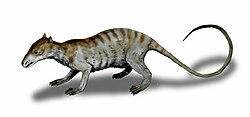| Jeholodentidae Temporal range: Early Cretaceous, | |
|---|---|
 | |
| Jeholodens jenkinsi | |
| Scientific classification | |
| Domain: | Eukaryota |
| Kingdom: | Animalia |
| Phylum: | Chordata |
| Class: | Mammalia |
| Order: | † Eutriconodonta |
| Family: | † Jeholodentidae Luo et al., 2007 |
| Type genus | |
| † Jeholodens Ji et al., 1999 | |
| Genera | |
† Yanoconodon Contents | |

The family Jeholodentidae is a possible eutriconodont family that was present in China around 125 million years ago during the time of the dinosaurs. There are currently two genera assigned to the family, Yanoconodon and Jeholodens . [1] [2]
However, recent studies have shown it to be paraphyletic in relation to Triconodontidae, with Yanoconodon being closer to them than to Jeholodens . [3]





